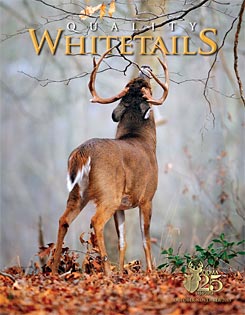Food Plot Species Profile -- Wheat
By: Kent Kammermeyer
Origin/Description
Grown practically everywhere in the U.S., wheat (Triticum aestivum) is one of the most valuable wildlife plants in the nation. The source of man’s “staff of life” is also the mainstay for wild creatures, especially deer. Deer eat the tender, nutritious (15-20% protein) foliage in fall, winter and spring as well as the mature seed when available in late spring and summer. Wheat is more cold tolerant than oats but not as cold tolerant or acid soil tolerant as rye. Of the three small grains, most experts would rank wheat as second in preference or palatability to oats with rye ranking third.
Originating in Iraq, Turkey, and Europe, wheat is one of the cool season annual bunch grasses that grow two to four feet tall, depending on variety, grazing pressure, and fertility.
Establishment/Mixtures
Wheat is usually planted in September in the North or October in the South. If planted alone, 90 to 120 pounds per acre is recommended. Planted in mixtures, no more than 60 pounds per acre (one bushel/acre) should be broadcast. Drill rates would be roughly half of the above broadcast rate. Personally, for deer, I would never really consider planting wheat alone for deer with one possible exception. Wheat fields serve as an ideal nursery for common ragweed. Generally, the best ragweed crops develop and mature in the stubble of the grazed seed heads. Deer browse ragweed quite heavily all summer. Otherwise, mix wheat with one or more legumes such as arrowleaf clover (10 pounds per acre, South), crimson clover (10 pounds per acre, South), red clover (10 pounds per acre, North or South), white clover (5 pounds per acre, North or South), Austrian winter peas (25 pounds per acre, North or South) or birdsfoot trefoil (10 pounds per acre, North). Besides adding palatability to the mix, the legumes make perfect companion plants for the wheat by fixing nitrogen in the soil (some of which is used by the wheat). On the flip side, the wheat acts as a nurse crop for the legumes for the first month after planting by producing vigorous early growth which takes the brunt of the early deer grazing pressure while the legumes develop a root system.
As with all other small grains, wheat will achieve greatest forage and seed production when soil is limed to raise pH above 6.0. A complete fertilizer applied according to soil test at planting (300 pounds of 19-19-19, for example) is highly recommended whether planted alone or in a mix.
Varieties/Management
There are dozens, if not hundreds, of wheat varieties planted all across the U.S. Some have been bred for forage production and these are probably the most appropriate for deer. Others have been bred for seed production and others for resistance to fungus, mildew, root rot, rust, and Hession fly — and every combination thereof.
Agricultural Extension agents should be consulted concerning diseases in a local area before growing wheat. Varieties that are resistant to disease and fungus should be selected for your local area. Disease-resistant varieties with high forage production can produce about 6,000 pounds of forage (dry weight) and 60 to 80 bushels per acre of grain if the best management practices are followed. These include using a higher seeding rate for forage production and sowing the crop early for deeper roots and greater ability to use soil moisture.
If grazing and grain production is your goal, apply at least one pound of nitrogen for every bushel of your yield goal and then top dress the crop at jointing in early spring with 0.75 pounds of nitrogen per bushel of yield goal. Do not apply the spring top dressing if you have planted the legume mix. The key to getting good wheat forage yields and grain yields is selecting a variety that fits your situation and operation. Do not plant “combine run” wheat, which is not inspected and can contain several species of noxious weeds. Recleaned seed or feed seed is cheap but it also has no guaranteed germination and a somewhat lower risk of noxious weeds. The risk is usually lower but it depends on how it was “cleaned.” Centrifugal cleaning and use of sieves or screens can eliminate noxious weeds but there are no guarantees.




























